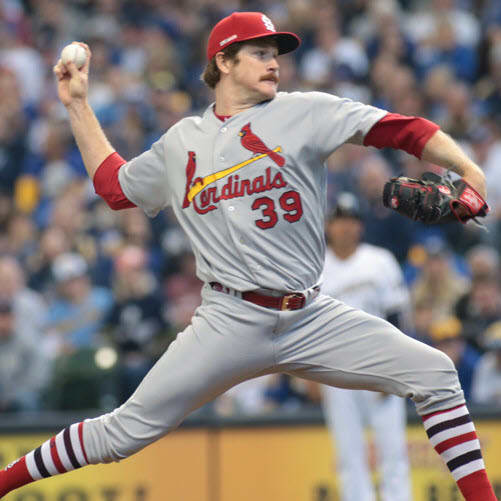This article is part of our Pitching 3D series.
It's the final round of our trek through the pitchers of each division, and we wrap up with the NL East, a division which boasts a handful of the best pitchers on the planet. It's also the final leg of our journey through pitching mechanics, and this week we take the puzzle pieces of the last five weeks and put them all together for an overall grade of pitching mechanics.
Before we get started, here are some quick links to the first five episodes of Pitching 3D:
Part 1: NL West, Balance
Part 2: AL West, Posture
Part 3: NL Central, Momentum
Part 4: AL Central, Torque
Part 5: AL East, Repetition
Overall Grade
The 20-80 scouting scale is used for each of the five subjects that we have previously covered on the mechanics report card: balance, posture, momentum, torque and repetition. In addition, I give each pitcher a letter grade for his overall delivery, based around a "C" average and with a bell-curve mentality. For the sake of comparison, in the 2015 Starting Pitcher Guide, I graded the mechanics of 250 different pitchers, and within that batch there were only six pitchers who received a straight-A and four others who were tagged with an A-minus.
Apparently, my overall evaluations run slightly on the optimistic side, as an internal audit of the grading system revealed that the average pitcher received a "C-plus" grade for the overall delivery. The letter grade is not a simple average of the five 20-80 scores;
It's the final round of our trek through the pitchers of each division, and we wrap up with the NL East, a division which boasts a handful of the best pitchers on the planet. It's also the final leg of our journey through pitching mechanics, and this week we take the puzzle pieces of the last five weeks and put them all together for an overall grade of pitching mechanics.
Before we get started, here are some quick links to the first five episodes of Pitching 3D:
Part 1: NL West, Balance
Part 2: AL West, Posture
Part 3: NL Central, Momentum
Part 4: AL Central, Torque
Part 5: AL East, Repetition
Overall Grade
The 20-80 scouting scale is used for each of the five subjects that we have previously covered on the mechanics report card: balance, posture, momentum, torque and repetition. In addition, I give each pitcher a letter grade for his overall delivery, based around a "C" average and with a bell-curve mentality. For the sake of comparison, in the 2015 Starting Pitcher Guide, I graded the mechanics of 250 different pitchers, and within that batch there were only six pitchers who received a straight-A and four others who were tagged with an A-minus.
Apparently, my overall evaluations run slightly on the optimistic side, as an internal audit of the grading system revealed that the average pitcher received a "C-plus" grade for the overall delivery. The letter grade is not a simple average of the five 20-80 scores; instead, the grades are weighted by importance, such that a pitcher's score for repetition will play a bigger role in his overall grade than will his score for posture. In general, the weighting hierarchy follows this order from top to bottom: repetition, balance, torque, posture, momentum. There are other aspects that are considered when deciding on the overall grade, such as a pitcher's release distance, so there is some leeway for personal preference.
It should come as no surprise that the pitchers with the best mechanics also happen to be some of the best pitchers in the game, with the list of "A" students including David Price, Madison Bumgarner and Corey Kluber. But there are exceptions, both in the sense of pitchers with great mechanics but spotty performance (i.e. Gio Gonzlaez) as well as pitchers with outstanding performance yet mechanical question marks (i.e. Clayton Kershaw). In general, mechanics play a vital role in performance and the best pitchers are utilizing their deliveries to their mechanical advantage, and a pitcher with an efficient delivery will have an easier path to maximize performance.
(stats for stuff provided by Brooks Baseball)
Julio Teheran
Teheran is coming off his worst season in the major leagues, following two seasons of exceptional work. There was some light at the end of the tunnel, with Teheran finishing the 2015 season with a shiny six-game run in which he allowed a 1.62 ERA, though a 32:16 K:BB ratio over that stretch tempers enthusiasm.
Stats: Even in his great seasons of 2013 and '14, Teheran's strikeouts were subpar from a fantasy standpoint. His value was tied to the ratio categories, as his stinginess for the free pass kept down the WHIP and he threw more than 400 innings of 3.03 ERA baseball. Somewhat remarkably, Teheran posted a winning record in 2015 despite his struggles as well as his pitching for the 95-loss Braves. His walk rate went from 5.8 percent over 2013-14 to 8.7 percent last season and the extra baserunners didn't do his ERA any favors, particularly when they scored on homers, another event that occurred at a career-high rate (3.2 percent) in 2015.
Stuff: His average fastball velocity of 92.0 mph was 0.7 higher than it was in 2014, and the batted-ball results were pretty much the same on his fastball for the last two years. Teheran's secondary pitches took most of the heat, including nine home runs off the slider and a .533 slugging percentage against the change.
Mechanics: Teheran drops his center-of-gravity to an incredibly low position during the stride phase of his delivery, utilizing one of the more severe drop-'n-drive deliveries in the game, and he finishes with a release point that is just 5.1 feet off the ground. He does well in the power categories, earning plus marks for his momentum and torque, but his pace down the mound was a bit slower last season and it had a ripple effect on his ability to repeat the timing of his delivery. Don't be fooled by the follow-through because his lateral stability is still strong enough to rank Teheran as above-average in terms of both balance and posture. His mechanics are generally very efficient and Teheran's overall rating was solid last season, but this is a pitcher who has graded out as a B+ in previous seasons and has some work to do if he wants to return to that level.

Mechanics Report Card
Balance: 55
Momentum: 60
Torque: 55
Posture: 60
Repetition: 50
Overall: B -
Jose Fernandez

Fernandez has the upside to be the best pitcher in the game, and he was on the fast track to the top of the mountain until his career was derailed by injury. He returned in midseason 2015 and enjoyed instant success, but his road back experienced some speed bumps when arm troubles put him back on the shelf for part of the second half.
Stats: They're all gorgeous. His career ERA is just 2.40 over 289 innings. He only notched 64.2 frames in 2015, but in that brief trial he struck out 29.8 percent of the batters he faced, which would have ranked fourth in baseball if sustained. In 2014, prior to going under the knife, that frequency was an incredible 34.2 percent in another small sample. Conventional wisdom states that control is one of the last things to come around following an elbow injury, but Fernandez's 5.3 percent walk rate was a career-best. He also keeps the ball in the yard and pitches his home games in a friendly park.
Stuff: Fernandez can bring legit triple-digit velocity and his average pitch-speed of 96.7 mph ranked sixth in the majors among starters. Some pitchers lose velo in their return from surgery, but Fern had nearly the exact same velocity prior to getting hurt, samples in which he was throwing harder than he was as a rookie in 2013. He is most known for his breaking ball, a pitch nicknamed "the Defector," which has devastating break and can take on multiple shapes. The Defector looks like a fastball out of hand, with a release-point trajectory that mirrors his other offerings. A pitch of that magnitude can be taxing, but Fern was not shy about his breaking ball usage, throwing the pitch more than 30 percent of the time.
Mechanics: Fernandez has the delivery and the build to inspire the future of pitching, but his experience is a reminder that efficient biomechanics are not a shield for injury, and that throwing crazy hard puts players at the biggest risk. A player of this caliber tests the physical boundaries of mechanical efficiency, and he is also testing the boundaries of what the human body can withstand. From the standpoint of this mechanical evaluator, Fern's delivery has it all: immense power, uncanny stability and the ability to repeat his timing and positioning at a rate that's well beyond his years. My favorite part of his delivery is the momentum, which involves a beautiful blend of power and efficiency by directing his ferocious energy directly at the target, starting from first movement into release point and follow-through.

Mechanics Report Card
Balance: 60
Momentum: 70
Torque: 70
Posture: 65
Repetition: 65
Overall: A
Bartolo Colon

Not who you expected? Matt Harvey's delivery is as electric as his stuff, Jacob deGrom's mechanics get better every time that I see him and Noah Syndergaard possesses an uncanny blend of balance and torque that produces the fastest average velo among the game's starting pitchers. Steven Matz certainly carries some intrigue, but we have all season to drool over Mets pitchers and I wanted to take this opportunity to give a nod to Colon. It is unreal what he is doing at his age and with his build, and this might be the last chance to fit him under the microscope.
Stats: If you're rostering Colon, then I'll assume that it's an NL-only league and you are in need of innings. Colon pitched a total of 587.1 innings in his age-40 through age-42 seasons and he kept the defense busy with just 6.2 K/9 and 1.3 BB/9 over that stretch. His 1.1 BB/9 of last season led the majors, but it was also his second straight year with an ERA over 4.00.
Stuff: He throws a darting fastball that can run 87-94 mph and... that's pretty much it. Colon leans on the fastball heavily, including 83.8 percent of the pitches that he threw last season, only to be interrupted by the occasional changeup or slider.
Mechanics: Great pitchers such as Randy Johnson, Roger Clemens and Nolan Ryan have improved their mechanical efficiency to unprecedented levels as they aged into their 40s, but Colon's delivery is hard to watch. His delivery works in gears, and though his momentum is slow it's directed along an efficient path to the plate. His torque is a joke, but Colon does maintain a semblance of balance and a decent stride. It's not pretty but he makes it work, and his incredible ability to repeat the motion is nothing short of shocking.

Mechanics Report Card
Balance: 50
Momentum: 50
Torque: 35
Posture: 45
Repetition: 70
Overall: C
Aaron Nola

The Phillies are poised for a long season as they kick-off the rebuilding project in earnest, but the team's place in the success cycle will likely result in a long leash and extended opportunities for young pitchers like Nola.
Stats: Nola was consistent last season, limiting the free passes to 2.2 BB/9 and only walking more than two batters in two of his 13 starts. The strikeouts never exceeded eight in any single ballgame but he whiffed at least six batters in seven different contests. The stats mirror his minor-league performance, in which Nola compiled 164.2 innings of 1.5 BB/9 while striking out just 7.5 batters per nine.
Stuff: Nola is considered to have a limited ceiling, and the source of that upside-related pessimism is a fastball that currently averages 91 mph and could lose more heat as he ages. He brings a healthy fastball-changeup-curveball mix to the rubber and the hammer is his strikeout weapon of choice, as when he gets two strikes Nola throws the pitch at least 44 percent of the time against batters from either side of the plate. In fact, 43 of his 68 strikeouts last season (63 percent) were finished by the curveball.
Mechanics: The report card looks plain, or maybe a lazy submission from a scout, but Nola personifies a plus delivery on every imaginable scale. His plus momentum is generated through an efficient direction as well as a strong pace to the plate, while his plus torque takes advantage of a delayed trigger as well as an upper-body load to create strong hip-shoulder separation. He has a bit of a hunch on his way into max leg lift and some drop on his way out, but the other elements of balance hold firm, and he maintains the plus stability through release point.

Mechanics Report Card
Balance: 60
Momentum: 60
Torque: 60
Posture: 60
Repetition: 60
Overall: B
Stephen Strasburg

Strasburg's career has been an adventure, with the right-hander teasing elite upside yet battling injury and inconsistency during his six-year career. The Nats lost Jordan Zimmermann over the offseason and Strasburg could very well be next in line, as the free-agent-to-be will be playing for a big payday in free agency.
Stats: Strasburg has fanned at least 26 percent of the batters he has faced and whiffed at least a batter per inning in every year of his career. The K/9 has exceeded double-digits in three of the last four seasons, each covering at least 125 innings. Durability is a question for a pitcher who missed chunks of June and July last season, but he had been on a three-year run of increasing workloads. Strasburg finished the season on an absolute tear, with a 1.24 ERA and 57 strikeouts against five walks in his last 36.1 innings of the regular season, with at least 13 strikeouts in three of those final five starts.
Stuff: The fastball is still intimidating, averaging 95.9 mph in 2015, but opposing batters had little problem in handling the pitch as 12 of his 14 homers allowed were hit on fastballs. His changeup would qualify as a fastball for some pitchers, hitting 88.9 mph, and both of his secondary pitches have been very effective. Batters don't stand a chance when the cambio or curve is en route, hitting a combined .166 with a .065 isolated power.
Mechanics: Strasburg often gets a bad wrap for his mechanics, and I have also grown frustrated with him as his efficiency seems to have gone backward since his days at San Diego State. At his worst, Strasburg strides off-line and ends up misaligned with the plate, such that he contorts his body to hit targets on the left side of the dish. Such was the case during the first half of 2015, but the delivery that was on display during the final six weeks of the regular season was as efficient as I have seen from Strasburg since he returned from Tommy John surgery four years ago. Everything clicks when he lines up the gears, with huge torque mixed with a stable delivery that allows his elite stuff to play up another notch. The inconsistency of his delivery during the season hurts his repetition grade in the report card below, but on a per-game basis he exhibited elite repetition by the end of the season.

Mechanics Report Card
Balance: 60
Momentum: 55
Torque: 70
Posture: 55
Repetition: 60
Overall: B+









